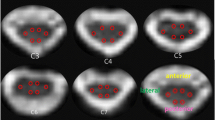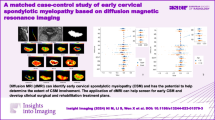Abstract
Purpose
To evaluate the effectiveness of Riluzole as a pharmacotherapeutic treatment option for early cervical myelopathy using clinical parameters and DTI analysis.
Methods
Early cervical myelopathy cases with MJOA scores ≥13, were recruited for the double-blinded, placebo-controlled randomised control trial. Thirty cases with fifteen cases each in the test and placebo group were studied. Analysis was done using diffusion tensor imaging (DTI) and clinical evaluation, pre- and post-institution of sodium channel blocker Riluzole for a period of 1 month (50 mg twice daily). Placebo group was treated with Vitamin B complex tablets. Diffusion co-efficient fractional anisotrophy (FA), apparent diffusion co-efficient (ADC), volume ratio (VR), relative anisotrophy (RA) and Eigen vectors were calculated. Outcomes analysis was based on clinical scores of MJOA, Nurick grading, SF-12, NDI, and statistical analysis of DTI datametrics.
Results
The mean MJOA score was 15.6 (13–17) with no significant change in the test and control groups. The mean ADC, FA values were 1533.36 (1238–1779) and 494.36 (364–628) and changed to 1531.57 (1312–2091) and 484.86 (294–597), respectively, in the Riluzole group. However, the changes in the values of ADC, FA, and other co-efficients including VR, RA and eigenvectors in the two groups were not statistically significant. The functional scores in the SF-12 and NDI questionnaires did not change significantly.
Conclusions
Our study did not show a significant change in the clinical outcome and DTI Indices with the use of Riluzole as a standalone pharmacotherapeutic agent for early cervical myelopathy. More studies may be needed to confirm the usefulness of Riluzole as a treatment option for cervical myelopathy.

Similar content being viewed by others
References
Rao RD, Currier BL, Albert TJ, Bono CM, Marawar SV, Poelstra KA, Eck JC (2007) Degenerative cervical spondylosis: clinical syndromes, pathogenesis, and management. J Bone Joint Surg 89(6):1360–1378
Shedid D, Benzel EC (2007) Cervical spondylosis anatomy: pathophysiology and biomechanics. Neurosurgery 60(1):S1–S7
Bernhardt M, Hynes RA, Blume HW, White AA (1993) Cervical spondylotic myelopathy. J Bone Joint Surg 75(1):119–128
Rao R (2002) Neck pain, cervical radiculopathy, and cervical myelopathy. J Bone Joint Surg 84(10):1872–1881
Kadanka Z, Mareš M, Bednarík J, Smrcka V, Krbec M, Stejskal L, Dušek L (2002) Approaches to spondylotic cervical myelopathy: conservative versus surgical results in a 3-year follow-up study. Spine 27(20):2205–2210
Kadaňka Z, Bednařík J, Novotný O, Urbánek I, Dušek L (2011) Cervical spondylotic myelopathy: conservative versus surgical treatment after 10 years. Eur Spine J 20(9):1533–1538
Sampath P, Bendebba M, Davis JD, Ducker TB (2000) Outcome of patients treated for cervical myelopathy: a prospective, multicenter study with independent clinical review. Spine 25(6):670–676
Yoshimatsu H, Nagata K, Goto H, Sonoda K, Ando N, Imoto H, Takamiya Y (2001) Conservative treatment for cervical spondylotic myelopathy: prediction of treatment effects by multivariate analysis. Spine J 1(4):269–273
Schwartz G, Fehlings MG (2001) Evaluation of the neuroprotective effects of sodium channel blockers after spinal cord injury: improved behavioral and neuroanatomical recovery with riluzole. J Neurosurg Spine 94(2):245–256
Thomsen C, Henriksen O, Ring P (1987) In vivo measurement of water self diffusion in the human brain by magnetic resonance imaging. Acta Radiol Diagn (Sweden) 28(3):353–361
Hoehn-berlar M, Eis M, Back T, Kohno K, Yamashita K (1995) Changes of relaxation times (T1, T2) and apparent diffusion coefficient after permanent middle cerebral artery occlusion in the rat: temporal evolution, regional extent, and comparison with histology. Magn Reson Med 34(6):824–834
Rajasekaran S, Kanna RM, Shetty AP (2012) Diffusion tensor imaging of the spinal cord and its clinical applications. J Bone Joint Surg Br 94(8):1024–1031
LaRocca H (1988) Cervical spondylotic myelopathy: natural history. Spine 13(7):854–855
Clarke E, Robinson PK (1956) Cervical myelopathy: a complication of cervical spondylosis. Brain 79(3):483–510
Lees F, Turner JA (1963) Natural history and prognosis of cervical spondylosis. Br Med J 2(5373):1607
Nurick S (1972) The natural history and the results of surgical treatment of the spinal cord disorder associated with cervical spondylosis. Brain 95(1):101–108
Symon L, Lavender P (1967) The surgical treatment of cervical spondylotic myelopathy. Neurology 17(2):117
Phillips DG (1973) Surgical treatment of myelopathy with cervical spondylosis. J Neurol Neurosurg Psychiatry 36(5):879–884
Katoh S, Ikata T, Hirai N, Okada Y, Nakauchi K (1995) Influence of minor trauma to the neck on the neurological outcome in patients with ossification of the posterior longitudinal ligament (OPLL) of the cervical spine. Spinal Cord 33(6):330–333
Bednařík J, Sládková D, Kadaňka Z, Dušek L, Keřkovský M, Voháňka S, Němec M (2011) Are subjects with spondylotic cervical cord encroachment at increased risk of cervical spinal cord injury after minor trauma? J Neurol Neurosurg Psychiatry 82(7):779–781
Rhee JM, Shamji MF, Erwin WM, Bransford RJ, Yoon ST, Smith JS, Kalsi-Ryan S (2013) Nonoperative management of cervical myelopathy: a systematic review. Spine 38(22S):S55–S67
Ducreux D, Lepeintre JF, Fillard P, Loureiro C, Tadie M, Lasjaunias P (2006) MR diffusion tensor imaging and fiber tracking in 5 spinal cord astrocytomas. Am J Neuroradiol 27(1):214–216
Demir A, Ries M, Moonen CT, Vital JM, Dehais J, Arne P, Dousset V (2003) Diffusion-weighted MR imaging with apparent diffusion coefficient and apparent diffusion tensor maps in cervical spondylotic myelopathy 1. Radiology 229(1):37–43
Mamata H, Jolesz FA, Maier SE (2005) Apparent diffusion coefficient and fractional anisotropy in spinal cord: age and cervical spondylosis-related changes. J Magn Reson Imaging 22(1):38–43
Avadhani A, Ilayaraja V, Shetty AP, Rajasekaran S (2010) Diffusion tensor imaging in horizontal gaze palsy with progressive scoliosis. Magn Reson Imaging 28(2):212–216
Rajasekaran S, Kanna RM, Karunanithi R, Shetty AP (2010) Diffusion tensor tractography demonstration of partially injured spinal cord tracts in a patient with posttraumatic Brown Sequard syndrome. J Magn Reson Imaging 32(4):978–981
Miller RG, Mitchell JD, Lyon M, Moore DH (2007). Riluzole for amyotrophic lateral sclerosis (ALS)/motor neuron disease (MND). Cochrane Database Syst Rev (1). doi:10.1002/14651858
Grossman RG, Toups EG, Frankowski RF, Burau KD, Howley S (2012) North American clinical trials network for the treatment of spinal cord injury: goals and progress. J Neurosurg Spine 17(1):6–10
Fehlings MG, Wilson JR, Karadimas SK, Arnold PM, Kopjar B (2013) Clinical evaluation of a neuroprotective drug in patients with cervical spondylotic myelopathy undergoing surgical treatment: design and rationale for the CSM-protect trial. Spine 38(22S):S68–S75
Schwartz G, Fehlings MG (2002) Secondary injury mechanisms of spinal cord trauma: a novel therapeutic approach for the management of secondary pathophysiology with the sodium channel blocker riluzole. Prog Brain Res 137:177–190
Karadimas SK, Gatzounis G, Fehlings MG (2014) Pathobiology of cervical spondylotic myelopathy. Eur Spine J 24(2):132–138
Author information
Authors and Affiliations
Corresponding author
Ethics declarations
Funding
The project was funded jointly by Ganga Orthopaedic Research & Education Foundation, Coimbatore and AO spine Asia Pacific.
Conflict of interest
The authors declare that they have no conflict of interest.
Ethical approval
The study has been approved by the Institutional research ethics committee and has been performed in accordance with the ethical standards as laid down in the 1964 Declaration of Helsinki and its later amendments or comparable ethical standards.
Informed consent
Informed consent was obtained from all individual participants included in the study.
Rights and permissions
About this article
Cite this article
Rajasekaran, S., Aiyer, S.N., Shetty, A.P. et al. Effectiveness of Riluzole as a pharmacotherapeutic treatment option for early cervical myelopathy: a double-blinded, placebo-controlled randomised controlled trial. Eur Spine J 25, 1830–1835 (2016). https://doi.org/10.1007/s00586-015-4323-1
Received:
Revised:
Accepted:
Published:
Issue Date:
DOI: https://doi.org/10.1007/s00586-015-4323-1




